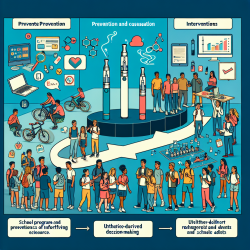Introduction
Air pollution is a significant environmental health concern that has been linked to various health outcomes. The study titled "Air pollution and general practitioner access and utilization: a population-based study in Sarnia, 'Chemical Valley,' Ontario" provides insights into how air pollution affects healthcare access and utilization in a high-exposure environment. This blog post aims to highlight the key findings of the study and discuss how practitioners can leverage this information to improve healthcare outcomes, particularly for children who are often more vulnerable to environmental pollutants.
Key Findings from the Study
The study conducted in Sarnia, Ontario, a region known for its high concentration of chemical processing facilities, found that exposure to pollutants such as nitrogen dioxide (NO2) and sulfur dioxide (SO2) is associated with increased utilization of general practitioner (GP) services. Specifically, the odds of GP use increased by 16% for NO2 and 61% for SO2 exposure. Moreover, low household income was a significant predictor of not having a regular family doctor in areas with high pollution levels.
Additionally, individuals without regular healthcare living in high pollution areas were more likely to report longer travel or wait times for care, with an odds ratio of 3.28 compared to their low-exposure counterparts. This suggests that environmental pollution exacerbates existing healthcare access disparities, particularly for socioeconomically disadvantaged groups.
Implications for Practitioners
Practitioners, especially those providing online therapy services to schools, can play a crucial role in mitigating the impacts of air pollution on healthcare access and utilization. Here are some actionable steps practitioners can take:
- Screening and Assessment: Incorporate environmental health screenings into routine assessments to identify children at risk due to high pollution exposure. This can help in tailoring interventions to address specific needs.
- Community Engagement: Engage with local communities to raise awareness about the health impacts of air pollution and the importance of regular healthcare access. Educational workshops can empower families to seek timely medical attention.
- Advocacy: Advocate for policies that address environmental health disparities and promote equitable access to healthcare services. Collaborating with local health departments and policymakers can drive systemic change.
- Telehealth Services: Utilize telehealth platforms to provide continuous care to children in high-exposure areas, reducing the need for travel and minimizing exposure to pollutants.
Encouraging Further Research
While the study provides valuable insights, further research is needed to explore the long-term health impacts of air pollution on children and the effectiveness of intervention strategies. Practitioners are encouraged to collaborate with researchers to contribute to this growing body of knowledge.
Conclusion
The study underscores the importance of addressing environmental health determinants in healthcare planning and delivery. By integrating data-driven approaches and community engagement, practitioners can enhance healthcare access and outcomes for vulnerable populations, particularly children in high-exposure areas.
To read the original research paper, please follow this link: Air pollution and general practitioner access and utilization: a population based study in Sarnia, 'Chemical Valley,' Ontario.










